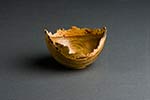Orchards: Generally terrible wood, lots of cracking problems. Don't ever bother with branch wood, regardless of size. Trunks might work, but will be a pain to dry. Problem is they are overwatered.
Trees in Lawns: Same issue as Orchards, unless it is a poorly water lawn.
Trees between street and sidewalk: usually great, usually not over watered. Look for root growth. Best wood comes from trees that have roots deeper in the ground.
Figure: You will get an eye for this after cutting open some trees. Starting near the base of the tree, you can usually tell from the outside if the wood has developed figure (curl/ripple/....). Take this wood regardless of the other statements and hope for the best.
Grain: If the end grain is open with large growth rings, the wood probably won't turn and finish nicely. Tight growth rings, closed pores usually will turn and finish nice. Then the question is does the piece have any character, or is it pretty bland. Bland - good learning, maybe coloring to give it some zip. Good color - nice.
Wood types: A lot of this depends upon what you want to turn, and your tastes/market if you are selling.
* Birch - This is a wood that can be turned very thin and pierced while wet. I love it for that purpose. Turn it wet and finish. Have made some bowls, but pretty pointless if you ask me. Might be good for coloring, just trying that. Paper Birch doesn't hold when turned thin.
* Ash - good hollow forms and for coloring. Pretty blah for bowls, but good turning wood to learn on. Nothing to special, but friends will love it.
* Maple - any variety has good uses. Silver maple is wonderful, but doesn't last, spalts beautifully but will turn to mush if you go to far. Curly maple is frequently used for coloring, just turned some into lumber for segmentation sometime next year, decent salid bowls but not that unique.
* Black Walnut - California walnut is wonderful, although you have to watch the dust. When the tree is sold for wood, the crotches still make great turnings. Don't bother with English walnut. Tends to be pretty blah. Union of black walnut and English can be interesting, but can be a pain to try to keep from cracking. Nice when you succeed.
* Carob - take all the big wood you can get. Branches, depend upon the amount of color (heart wood). Sometimes this is almost all the wood, sometimes a very small part. The sap wood (off white) is very unstable and tends to crack significantly unstable, not worth the fight.
* California Bay - Not a popular wood with the club members, but a great wood to learn with. Turns nice, just a little blah when done.
* Liquid Amber - spalted can be beautiful. Turns nice, great practice wood.
* Red Bark Euc, Cork wood - Great natural edge with the bark on.
* Oak's - Haven't found any worth the trouble. Live Oak can make some nice stuff, but at least 50% will crack and be useless.
* Madrone - I like this wood, makes very nice turnings, but I have to boil this or it is useless.
* Olive - I like this stuff. Some turn it with bark for natural edge. Tends to crack no matter what you do, so I don't make functional things out of it. Might try some stone inlay in a piece after we get our class. Some hate it, as it will rust your lathe in nothing flat, and never dries. I've had some stuff for 8yrs and it is still wet.
* Apricot - tends to be orchard wood, and moves/cracks. Makes nice turnings if you can get past the cracking.
* Bamboo - with epoxy I've seen some rather interesting turnings. I'm going to try this sometime soon.

